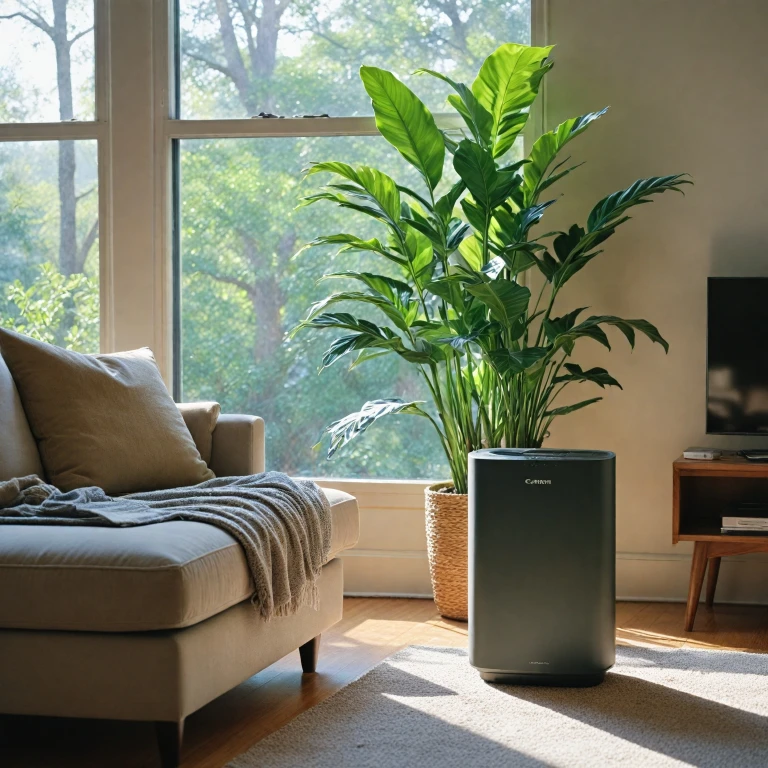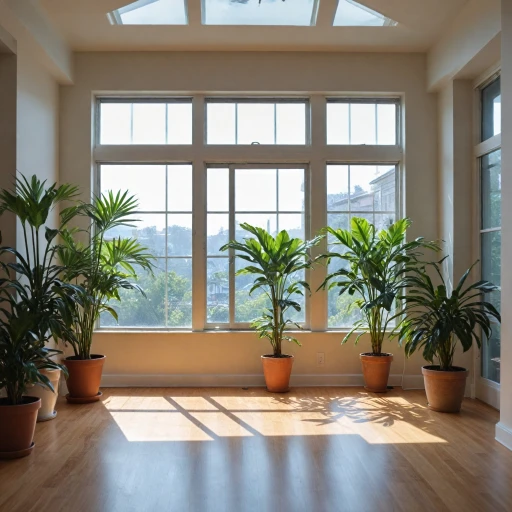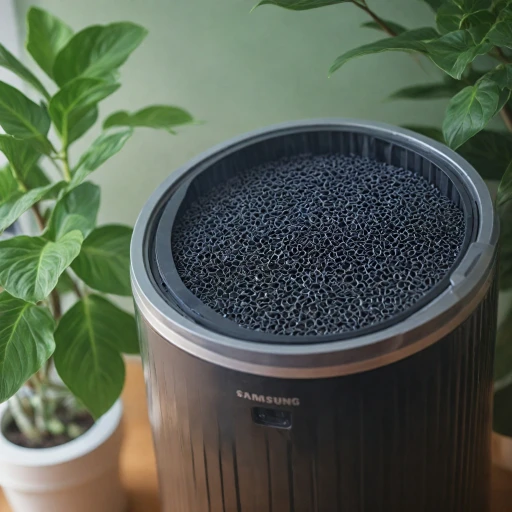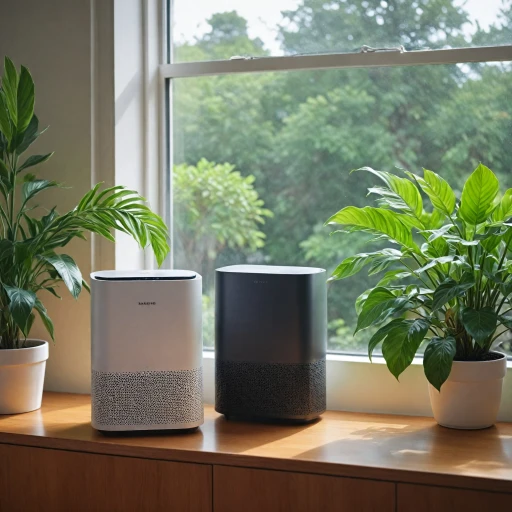How Carbon Air Purifiers Work
How Activated Carbon Works in Purifiers
Understanding the operation of carbon air purifiers begins with their core component: the activated carbon filter. By leveraging the properties of activated carbon, these filters excel at trapping contaminants and enhancing air quality. So, what makes activated carbon so effective? Activated carbon is a highly porous form of carbon that attracts and holds various pollutants. When air flows through a purifier equipped with a carbon filter, volatile organic compounds (VOCs), smoke, and odors adhere to the carbon’s surface. Unlike some technologies that mask odors, carbon air purifiers genuinely improve the purity of the air by removing its contaminants. These purifiers differ from HEPA filters, which capture particulate matter rather than gaseous pollutants. While some models, like the Coway Airmega or Blue Pure series, combine both HEPA and carbon filtration, the carbon filter’s ability to manage smoke and VOCs sets it apart. Moreover, carbon filters are a crucial component of professional-grade systems like the Allerair Airmedic Pro and Pro Vocarb, engineered to handle specific air quality concerns efficiently. They offer a higher level of filtration, suitable for sensitive environments. For a more comprehensive understanding of how these filters work, explore the benefits of activated carbon in air purification. This link provides deeper insights into these systems, though the fundamental concept remains the same: with high-speed air circulation and proper maintenance, carbon purifiers significantly benefit clean air enthusiasts. When weighing the price and free shipping options on platforms like Amazon, remember to consider the specifics: coverage area, CFM (cubic feet per minute), and the year warranty. These factors, combined with a reliable filtration system, ensure fine air quality maintenance year-round. For more on maintaining and selecting the right carbon air purifier, delve deeper into the topic to ensure you’re making an informed choice.Benefits of Using Carbon Air Purifiers
Discovering the Advantages of Using Carbon Air Purifiers
The use of carbon air purifiers brings a host of benefits that make them an attractive option for enhancing indoor air quality.- Effective VOC Filtration: One of the standout features of carbon air purifiers is their ability to filter volatile organic compounds (VOCs) from the air. VOCs are emitted from common household items and can harm indoor air quality. Carbon filters effectively adsorb these gases, resulting in cleaner indoor air.
- Efficient Removes of Smoke and Odors: Activated carbon is particularly effective at trapping smoke and unpleasant odors. Whether it’s cigarette smoke or cooking smells, these purifiers can handle them with great efficiency.
- Versatility with HEPA: Many models combine carbon and true HEPA filters, offering a comprehensive filtration solution. This combination enhances the purifier's capability to remove not only gases but also particles like dust and allergens.
- Wide Coverage and Options: Products like the Coway Airmega and Blue Pure are known for covering large spaces with high Clean Air Delivery Rate (CFM). With options available on platforms like Amazon, homeowners can find purifiers tailored to their specific needs, with varying coverage areas and speeds.
- Cost-Effective Choices: While the price of carbon air purifiers can vary, there are options that provide excellent value for money, often including benefits like free shipping and multi-year warranty options.
- Medical-Grade Solutions: Some air purifiers, like the AllerAir AirMedics series, offer medical-grade filtration with high-density carbon filters, which cater specifically to individuals with severe allergies or respiratory issues.
Comparing Carbon Air Purifiers to Other Types
Comparative Insights on Air Purifiers: Why Carbon Stands Out
When weighing your options for air purification, it's essential to understand how carbon air purifiers stack up against other types available on the market. Each purifier employs unique filtration methods, and understanding these can make a significant difference in your choice for a cleaner home environment.
Carbon air purifiers utilize activated carbon filters to effectively capture and neutralize volatile organic compounds (VOCs), smoke, odors, and various airborne pollutants. This makes them particularly effective in homes where air quality might be compromised by high VOCs—often emitted by household products or tobacco smoke.
Key Differences with HEPA Filters
While HEPA air purifiers are renowned for removing particulates, including dust, pollen, and pet dander, they may not be as effective when it comes to VOCs or odors. That's where carbon air purifiers excel. Their activated carbon technology captures these gaseous pollutants, offering a more comprehensive filtration approach, particularly in combating smells and chemical odors.
Comparing Costs and Coverage
- Purifiers like the Airmedic Pro and AllerAir AirMedic fall in varying price ranges but are generally seen as worthwhile investments for their specialized filtration systems.
- The Coway Airmega and Blue Pure lines offer both HEPA and carbon filtering options, catering to diverse air quality needs. When operating at the highest setting, these purifiers can cover larger spaces with high CFM (cubic feet per minute) ratings.
Maintenance and Value Consideration
Carbon filters require regular replacement to maintain their effectiveness. It's worth considering the annual costs associated with filter replacements relative to the benefits of having cleaner air. Additionally, the durability and year warranty offered by many manufacturers can also provide peace of mind.
With free shipping options available on platforms like Amazon for many carbon purifiers, and the convenience factor of home delivery cannot be overlooked. This ease in acquiring clean air solutions can significantly enhance your living space, as expanded on in our detailed guide on improving your home's air quality.
Choosing the Right Carbon Air Purifier for Your Home
Factors to Consider When Choosing a Carbon Air Purifier
When deciding on a carbon air purifier for your home, it is essential to evaluate several factors to ensure you make an informed decision. A well-chosen air purifier can significantly enhance your indoor air quality by effectively trapping pollutants like VOCs and smoke.
- Filtration Efficiency: Look for air purifiers that feature both activated carbon filters and HEPA filters. The combination of these two provides optimal filtration, capturing a wide range of pollutants.
- Room Coverage: Consider the size of the area you wish to purify. Manufacturers often specify the area in square feet that their air purifiers can effectively cover. The larger the coverage, the higher the CFM (Cubic Feet per Minute) you might need. Brands like Coway Airmega and Blue Pure offer models catering to different room sizes.
- Speed and Settings: Many carbon air purifiers come with variable speed settings. Higher settings can clean the air faster but may increase noise levels. Ensure to select a model with adjustable speeds to balance power and quiet operation.
- Price and Shipping: Set a budget that reflects your requirements. Prices can vary widely, with premium models offering advanced filtration technology like AllerAir AirMedic Pro Vocarb having higher price points. Always check for options that include free shipping and verify warranty terms, typically spanning a year warranty or longer.
- Brand Reputation: Choose reputable brands that focus on quality air purification. Products like those from AllerAir AirMedic and Airocide often come with medical-grade filters, providing assurance of high filtration quality.
Evaluating these aspects carefully can help you select a carbon air purifier tailored for your indoor environment, balancing performance with budget and specific filtration needs. For additional insights into air purification mechanics, check the previous discussions on how carbon filters capture pollutants and factors like VOCs in the air.
Maintenance Tips for Carbon Air Purifiers
Ensuring Longevity and Optimal Performance
Proper maintenance of carbon air purifiers is crucial to ensure their longevity and optimal performance. Without regular upkeep, even the best filters can become less effective over time, impacting the air quality in your home. Here are some key maintenance tips to keep your air purifier running smoothly:- Regular Filter Replacement: Just like HEPA filters, carbon filters need to be replaced periodically. The frequency depends on the air purifier model and usage, generally every 6 to 12 months. Consider models like the Coway Airmega or AllerAir AirMedic which offer easily accessible filters for hassle-free change.
- Checking Airflow: Ensure that no objects are blocking the air intake or output. This is essential for maintaining a high Clean Air Delivery Rate (CADR) at maximum speed settings. A blocked filter can result in reduced CFM (Cubic Feet per Minute) efficiency.
- Cleaning the Unit: Dust and debris can accumulate on the exterior and interior parts of the purifier. Use a soft, dry cloth to clean the outer surfaces regularly. To clean inside, refer to the product’s manual to avoid any damage.
- Monitor Air Quality: Some advanced units come with built-in air quality sensors. Regularly check these readings as part of your maintenance regimen to determine if there are any issues with your filters or purifier operation.
- Speed Settings: Use different speed settings as needed. Prolonged operation at the highest setting, while effective against smoke and VOCs, can increase wear. Ensure your model, such as the AirMedic Pro or Blue Pure, supports varied settings for energy efficiency.
- Warranty and After-Sale Support: Check the year warranty and register your product for customer support. Trusted brands offer quality service and free shipping for components under warranty, giving peace of mind and ensuring your investment is protected.
Addressing Common Concerns About Carbon Air Purifiers
Addressing Common Concerns About Carbon Air Purifiers
When considering a carbon air purifier, you might have some questions or concerns. Here, we address some of the most common issues people have about these devices.
Do Carbon Air Purifiers Remove All Pollutants?
Carbon air purifiers are particularly effective at removing volatile organic compounds (VOCs), odors, and smoke from the air. However, they might not capture all types of pollutants. For instance, while carbon filters excel at absorbing gases, they are not as effective at capturing particles like dust or pollen. For a more comprehensive solution, consider a purifier that combines a carbon filter with a HEPA filter. This combination can address both gaseous pollutants and particulate matter, enhancing overall air quality.
How Often Should I Replace the Carbon Filter?
The lifespan of a carbon filter can vary based on usage and air quality conditions. Generally, it's recommended to replace the filter every 6 to 12 months. Some models, like the AllerAir AirMedic Pro, may offer longer-lasting filters. Always refer to the manufacturer's guidelines for the best results. Regular maintenance ensures your purifier operates at its highest setting, providing clean air consistently.
Are Carbon Air Purifiers Expensive?
The price of carbon air purifiers can vary significantly, from budget-friendly options to high-end models like the Coway Airmega or Blue Pure. While upfront costs might seem high, consider the long-term benefits of improved air quality and health. Additionally, many retailers offer free shipping and year warranties, adding value to your purchase.
What About Noise Levels?
Noise can be a concern for some users. Most carbon air purifiers operate quietly, especially on lower settings. However, at the highest speed, some noise is inevitable. It's advisable to check the specifications for the noise level, often measured in decibels (dB), before purchasing. A model with multiple speed settings allows you to adjust the noise level according to your preference.
How Do I Know If It's Working?
Many modern air purifiers come with air quality indicators, which provide real-time feedback on the air's condition. This feature can reassure users that the purifier is effectively improving air quality. Additionally, noticeable reductions in odors or smoke can be a clear sign of the purifier's efficacy.





